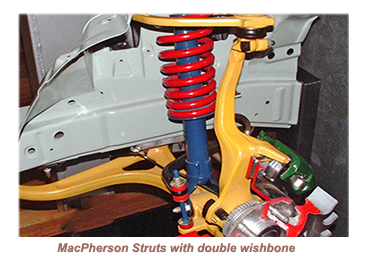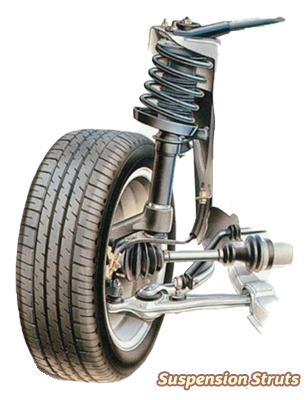
Maintaining the suspension struts on a classic car will ensure that the vehicle continues to provide a smooth and comfortable ride, while at the same time improve handling and stability.
Classic cars frequently feature suspension designs that vary from contemporary models, and their components may be more susceptible to wear as a result of ageing.
Regular maintenance is essential to avoid expensive repairs and ensure a smooth, responsive driving experience.![]()
![]() Inspect the suspension struts for any signs of leaks. The most common reason why front struts will begin to leak in a classic car is simply because they have aged!
Inspect the suspension struts for any signs of leaks. The most common reason why front struts will begin to leak in a classic car is simply because they have aged!
 In the case of a restored classic car, where the struts are relatively new, they may still spring a leak after as a result of accident damage, seerious enough to have caused the struts to become bent or dented.
In the case of a restored classic car, where the struts are relatively new, they may still spring a leak after as a result of accident damage, seerious enough to have caused the struts to become bent or dented.
Whatever the reason, a vehicle driven on leaking struts is consider unroadworthy and the struts should be replaced immediately. Driving on damaged struts is not only dangerous but will make for a very uncomfortable ride with the vehicle’s road holding severely impaired.
![]() Inspect the struts for any signs of wear or damage, such as dented or corroded cylinder tubes or bent shafts. If you notice any issues, have the struts replaced at the earliest possible opportunity.
Inspect the struts for any signs of wear or damage, such as dented or corroded cylinder tubes or bent shafts. If you notice any issues, have the struts replaced at the earliest possible opportunity.
![]() Test the suspension struts by pushing down on the corners of the vehicle.
Test the suspension struts by pushing down on the corners of the vehicle.
 The role of the suspension strut is not only to dampen excess spring fluctuation, and prevent vehicle from spinning, the effects of the upper control arm and ball joint are also eliminated by the diagonal mounted strut, situated between the strut tower and the steering knuckle .
The role of the suspension strut is not only to dampen excess spring fluctuation, and prevent vehicle from spinning, the effects of the upper control arm and ball joint are also eliminated by the diagonal mounted strut, situated between the strut tower and the steering knuckle .
 The point of carrying out a bounce test on the shock absorber system to assess its dampening capabilities. If the shock is worn, it will bounce several times after pressure has released. This provides real time proof that the shock absorbers have lost their ability to dampen the instability of the springs.
The point of carrying out a bounce test on the shock absorber system to assess its dampening capabilities. If the shock is worn, it will bounce several times after pressure has released. This provides real time proof that the shock absorbers have lost their ability to dampen the instability of the springs.
If the struts are working properly, the vehicle should rebound quickly and not sway or continue to bounce.
![]() Make sure the ride height is at factory-specified level as can found in to owner’s manual. If the ride height turns out be lower than specified, it is an almost certain indication that the struts are wearing out, meaning the suspension is in a faulty or even dangerous condition.
Make sure the ride height is at factory-specified level as can found in to owner’s manual. If the ride height turns out be lower than specified, it is an almost certain indication that the struts are wearing out, meaning the suspension is in a faulty or even dangerous condition.
![]() Any unusual noises coming from the suspension struts, such as clunking or rattling sounds, indicate a problem with the struts and should be addressed as soon as possible.
Any unusual noises coming from the suspension struts, such as clunking or rattling sounds, indicate a problem with the struts and should be addressed as soon as possible.
![]() Rust can cause damage to the struts over time, so it's important to regularly inspect the struts for signs of rust. If rust is present, have it removed and treated to prevent further corrosion.
Rust can cause damage to the struts over time, so it's important to regularly inspect the struts for signs of rust. If rust is present, have it removed and treated to prevent further corrosion.
 It's important to take into account that classic cars may have different types of suspension struts than the modern cars, it's always better to consult the manual or take the advice of a professional mechanic familiar with the specific make and model of your classic car. Regular inspection and maintenance can help extend the life of your classic car's suspension struts and can avoid costly repairs in the future.
It's important to take into account that classic cars may have different types of suspension struts than the modern cars, it's always better to consult the manual or take the advice of a professional mechanic familiar with the specific make and model of your classic car. Regular inspection and maintenance can help extend the life of your classic car's suspension struts and can avoid costly repairs in the future.
Back to the homepage- and don't spare the horsepower.
ub4





